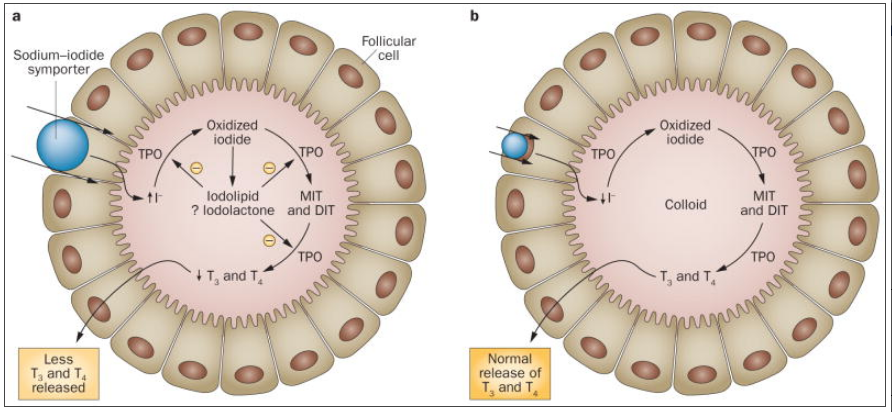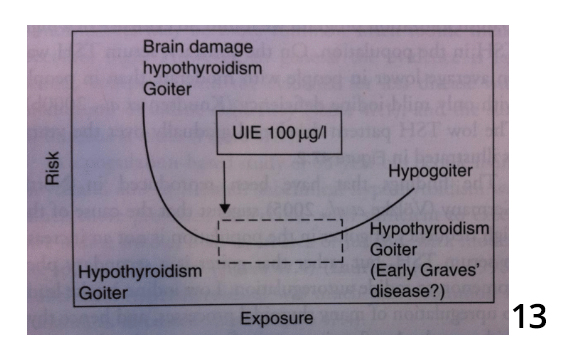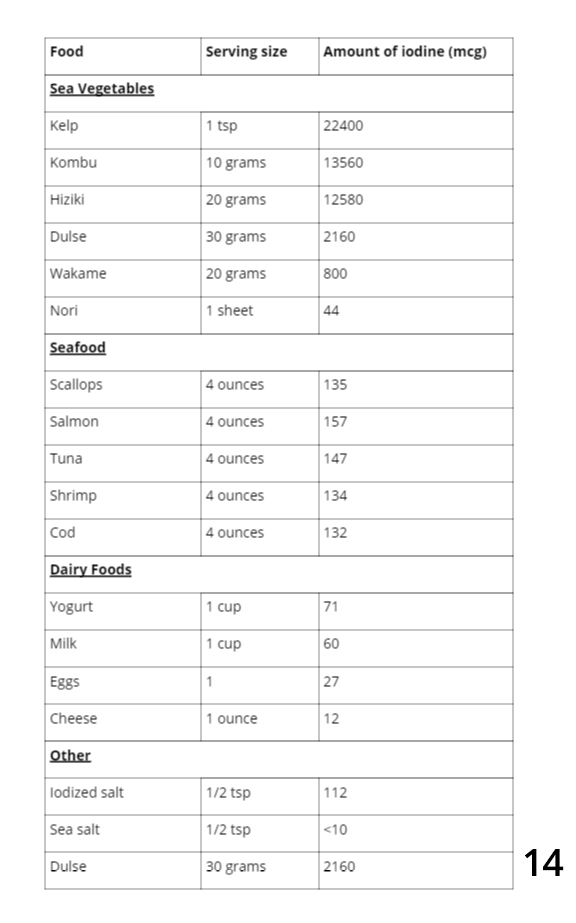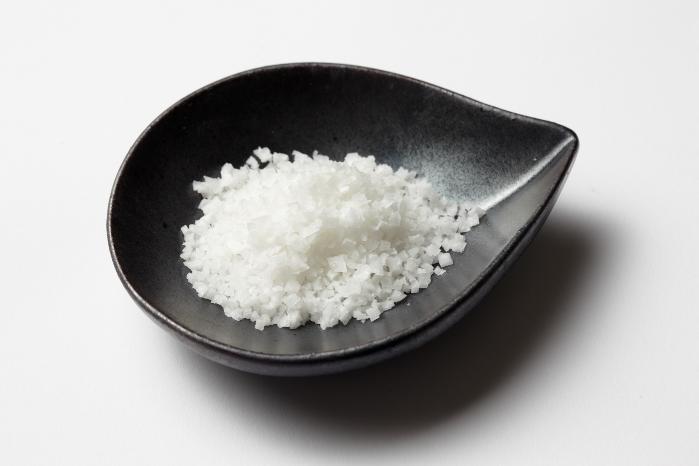Today, I want to talk to you about iodine. More specifically, I want to discuss how much iodine you need for thyroid disease.
You might have noticed that I recently shared an article about how 78% of people can reverse thyroid disease with iodine restriction. Since then, I have gotten the same question multiple times: How much iodine is safe if I have had thyroid disease?
Let me help you by jumping into the science, and what it means for your health, right now.

How Iodine Is Essential
Iodine is a pretty unique mineral, in the sense that it only serves one known purpose in the body: the formation of thyroid hormones. When you hear about thyroid hormones, like the T4, the T3, the T2, all of those relate back to the thyroglobulin protein a certain number of iodine atoms.
Honestly, that is all that we know about iodine and what it does in our body. If you think about other minerals, like magnesium, selenium, or zinc, that’s going to sound pretty weird. That’s because all these other minerals have anywhere between dozens to hundreds of roles in the body.
Early on in the evolutionary past, humans simply did not have a lot of exposure to iodine (only in trace amounts). This means that we had the ability to pump it, at a great concentration, right inside the gland.
Because of that, we have had the ability to get by on a pretty good range of iodine intake in our system. But what if we have too little? It could get to the point where there is not enough iodine to get the thyroid to work.
It would seem intuitive to think that, if your thyroid needs iodine, and that too little makes it not work, that more iodine should help your thyroid perform better than before. The problem is that more iodine is not always better for the body.
Bottom Line: The way we are able to pump in and concentrate iodine also makes us vulnerable to getting too much. That’s a total paradox, and is why I have dubbed iodine the “goldilocks mineral.” Too little is bad, too much is bad, you need it to be just right.
Iodine: Too Little
If you have ongoing exposure to under 50 micrograms of iodine per day, this can lead to iodine deficiency, hypothyroidism, or even goiter (thyroid enlargement). How does it happen? There are two distinct ways:
- You live somewhere with no iodine fortification and low-iodine soils, or
- Your diet is devoid of all high-iodine foods, alongside a high intake (2 pounds per day) of uncooked cruciferous vegetables
Iodine: Too Much
If iodine is a nutrient, what is the harm in having a little bit extra? As I mentioned before, getting too much iodine can be disastrous for your health. In fact it can result in what we know as the Wolff-Chaikoff effect, where a large ingestion of iodine causes the thyroid to shut down completely.

This extra iodine shrinks the iodine receptors (which are illustrated in the image above as the blue circles), which leads to poor iodine uptake in the body. Following that, this decrease in uptake stops the gland from working altogether for 2 – 3 weeks.
In those with goiters, high intake can lead to stimulation of goiter – this ultimately leads to hyperthyroidism. This has also been termed the Jod-Basedow effect.
Is A High Iodine Dose Ever Appropriate?
There are times when a high dosage of iodine might be appropriate. These include:
- Thyroid Storm1, and
- Pre-Surgery for Graves Disease2
Key Insight: A high dose of iodine is the single-most effective treatment for stopping a dangerously overactive thyroid gland – which is specifically why we see them used in the above situations.
We might also see a large dosage of iodine in a case of radioactive iodine exposure (Read: Is iodine what you need to prevent radiation exposure). If a child, or an adolescent, is going to be exposed to radioactive iodine in the coming days, a high dose can close the receptor to stop their thyroid and prevent their gland from absorbing radioactive iodine.3
Bottom Line: While we might see certain instances where a high dosage of iodine is helpful, it typically only occurs in emergency situations that we want to avoid in the first place. It is more of a “break glass in case of emergency” tool.
Thyroid Cancer Risk & Iodine
This is a dangerous one that I really want to talk about. As I began diving more into the research behind iodine, the research done across the globe has made it more and more clear that increased amounts of iodine can correlate to increase instances of thyroid cancer developing in certain populations.
Here’s what research has found in:
- Australia, iodine supplementation in salt lead to a doubling of thyroid cancer rates.4
- Sweden, a higher intake of iodine correlated with higher risk of papillary thyroid carcinomas.5
- Korea, rates of thyroid cancer elevated 10 fold in relation to increased iodine intake.6
Key Insight: It really is as simple as this – the higher intake of iodine there is, the greater risk that we have for thyroid cancer.
Hyperthyroidism & Hypothyroidism
When it comes to both hyperthyroidism and hypothyroidism, we need to understand that iodine – as the goldilocks mineral – has a cause and effect relationship with both conditions:
- In Hyperthyroidism, rates have increased 36 – 64% after iodine fortification.7
- In Hypothyroidism, higher iodine intakes lead to higher rates of hypothyroidism. According to one study, hypothyroidism is an increasing trend when accompanied by iodine intake. Ultimately this was caused by autoimmune thyroiditis.8
Goiters
To date, the highest incidences of goiters (Read: A comprehensive guide to goitrogens and hashimotos) occur in the parts of the world which have the highest intake of iodine (particularly in China and Japan). In Hokkaido (Japan), for example, 6 – 12% of the population were suffering from goiters.9
By that same token, in Shanxi Province in China, the goiter rate was 65%. This was due to the high concentration of iodine in their water, leading to a much higher rate of goiter occurrence than anywhere else in the world.10
Bottom Line: If anything, learning more about goiters should give you more insight into the structure of your thyroid and just how important it is in your body. There are steps you can take to handling goiters, and I would be happy to help you learn even more about them (Read: Goitrogen Clarity).
Thyroid Nodules
Thyroid nodules are most common, throughout the world, in areas that have large amounts of iodized salt. This is especially true for those who enjoy large amounts of iodine-rich seaweed.11 This was especially true in post-menopausal women, in which case eating seaweed was positively associated with increased rates of papillary thyroid cancers.12
What are they, though? Thyroid nodules are abnormal lumps of thyroid tissue. They can be caused by exposure to radiation, and by both a deficiency in iodine, or an excess of iodine. While on the whole, thyroid nodules are not dangerous, they can have associated symptoms (like trouble swallowing) which are uncomfortable for some.
Bottom Line: There are ways you can deal with thyroid nodules naturally (Thyroid nodules, the full story and how to treat them naturally), but what you need to know for our conversation today is that they can certainly be affected by iodine – and the research bears this out entirely. Knowing more about them leads to better thyroid management and better overall health.
How Much Iodine Is Best For Early-Onset Thyroid Disease?
Studies have shown that less than 100 micrograms total of iodine can lead to a 78% chance of reversing hypothyroidism (due to Hashimoto’s thyroiditis).
Given that information, I want to share with you some of the other ideal dosages for those who currently have thyroid disease. No matter where you are right now, here is the appropriate amount that you should consider and dial into for the amount of iodine coming into your system:
- What if you are on thyroid medication and want to stay stable? 100 – 300 micrograms would be best.
- How much is best if you have autoimmune thyroid disease or hypothyroidism and want to make your thyroid work better? Less than 200 micrograms, if possible, per medication.
- How much is best if you want to avoid thyroid disease? 100 – 300 micrograms is ideal.
Bottom Line: As I have mentioned before, you need to ensure that you are getting exactly the right amount of iodine to ensure that you handle thyroid disease correctly. If you get it wrong, you run into serious risks, so please ensure that you are dealing with the right amounts.

Your Day’s Total Iodine Intake
So, how do you figure out how much iodine you are taking into your system on a daily basis? There are three basic areas of focus that we want to hone in on, which are your:
- Medications
- Supplements
- Diet
Your Medications
There are two examples that I want to present to you to help make sense of this one: natural desiccated thyroid (NDT) and T4. For your NDT (Read: The top 5 myths about natural desiccated thyroid), you need to consider it in terms of roughly 0.2% of your tablet.
This means that a 1 grain dose of Naturethroid (a 65 mg tablet) has 130 mcg of iodine (we get to this number by multiplying the tablet’s weight (65) by the percentage of which it has iodine within it (0.2), which gives us 0.13 (milligrams), which we then multiply by 100 to get 130 micrograms). Sound simple enough? It is!
Next, we’ll consider our T4. If we have 100 micrograms of Synthroid or Levoxyl, with a medication that has 65% potency, all we have to do is multiply the size (100) by the potency (65) to arrive at the amount of iodine. In this event, we have 65 micrograms of iodine.
Bottom Line: Understanding more about your medications, and what they include, is pivotal in your overall health – especially as it concerns how much iodine you are getting into your system. Please be sure to have a well-rounded sense of what medications you are on, and how they are working for you.
Your Supplements
It is so important to keep a very close eye on the supplements you are taking, and how much iodine is in each of them. Read all of your labels, and take into account the amount of iodine you have in terms of micrograms. If you see them in milligrams, please make sure to convert.
Your Diet
How much iodine are you getting in your diet? If you are not sure, this is where you will want to start. First and foremost, start with 40 micrograms (from a diet made up of low-iodine foods).
Key Insight: Did you know that the majority of the iodine (from salt) in our diets does not come from the foods we cook at home? It is more likely to come from the foods we order at restaurants, or the pre-made meals we find in grocery stores.
Please take a moment to refer to this chart, and to use it time and time again, in order to give yourself a much deeper understanding of how much iodine the foods you eat is going into your system…

Your Iodine, In Check.

Now that you know a bit more about how you can keep your iodine at its optimal levels, and what those levels might be for those with thyroid disease, you are better equipped to start taking back your health and getting back to 100%. Feel like you might also need to quickly check in with the health of your thyroid? Consider the Thyroid Quiz (Click Here) today, in order to give yourself a deeper understanding of your overall health, and what you can do to make it better.

Sources
1 – https://www.ncbi.nlm.nih.gov/pmc/articles/PMC3475282/
2 – https://www.ncbi.nlm.nih.gov/pmc/articles/PMC2498739/
3 – https://www.ncbi.nlm.nih.gov/pmc/articles/PMC4026146/
4 – https://www.ncbi.nlm.nih.gov/pubmed/9349576
5 – Iodine supplementation in Sweden and regional trends in thyroid cancer incidence by histopathologic type. Pettersson B, Coleman MP, Ron E, Adami HO. Int J Cancer. 1996 Jan 3; 65(1):13-9.
6 – https://www.ncbi.nlm.nih.gov/pubmed/22391027
7 – https://www.ncbi.nlm.nih.gov/pubmed/9553166
8 – https://www.ncbi.nlm.nih.gov/pubmed/9302377
9 – https://www.ncbi.nlm.nih.gov/pubmed/4158495
10 – https://www.ncbi.nlm.nih.gov/pubmed/15817861
11 – https://www.ncbi.nlm.nih.gov/pubmed/8106628
12 – https://www.ncbi.nlm.nih.gov/pubmed/22414981
13 – Comprehensive Handbook of Iodine Ed. Preedy V. Burrow G, Watson R. Elsevier 2009.
14 – https://www.ncbi.nlm.nih.gov/pmc/articles/PMC3976240/

1. Schedule a Thyroid Second Opinion with me, Dr. C, Click Here for Details
2. Download and use my Favorite Recipes Cookbook Here
3. Check out my podcast Medical Myths, Legends, and Fairytales Here
Dr. Alan Glen Christianson (Dr. C) is a Naturopathic Endocrinologist and the author of The NY Times bestselling Adrenal Reset Diet, The Metabolism Reset Diet and The Thyroid Reset Diet.
Dr. C’s gift for figuring out what really works has helped hundreds of thousands of people reverse thyroid disease, lose weight, diabetes, and regain energy. Learn more about the surprising story that started his quest.


